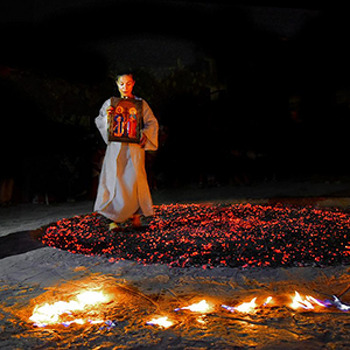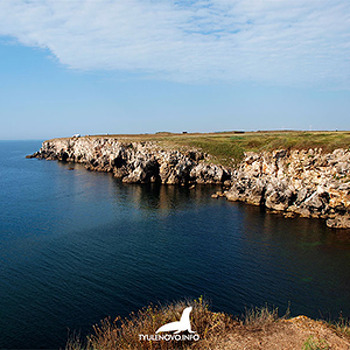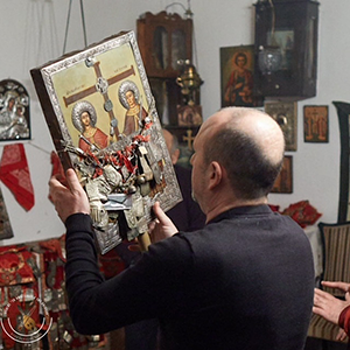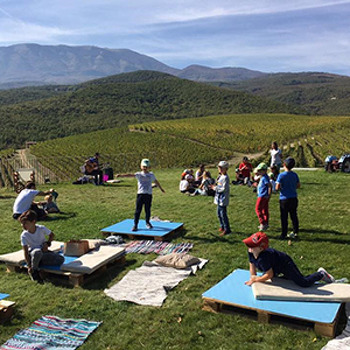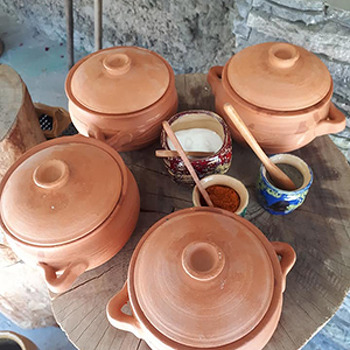Key facts and figures
Armenia is located in the northeastern part of the Armenian Highland. In north the country borders with Georgia, in south – with Iran, in east – with Azerbaijan, in west – with Turkey. The current territory of the Republic of Armenia is 29 743 square km and is situated about 1800 m above sea level. The highest point is mount Aragats (4090 m), the lowest – canyon of the rivers Debed (in the North-East) and Araks (in the South) (about 375 m). Yerevan is the capital of the country. According to the Armenian Statistic Committee the population of the RA is 2 959 700 which 63.9% are urbans (living in 49 cities).
The RA also stands out with its various natural-climatic peculiarities. It is located in the Alpine-Himalayan geosyncline zone, has a pronounced mountainous terrain, which, due to its location in the subtropical climate zone, stands out for its diverse natural conditions and landscapes (desert-semi-desert, steppe, forest, meadow-steppe, alpine, near-alpine, snow-covered). The mountainous nature of the RA, being far from the sea basins and being in the subtropical transitional climate zone has left its impact on the peculiarities of the country's climate, which is also distinguished by diversity (from dry subtropical to snowy) and expressed in 4 seasons of the year. The RA has a terrestrial climate, which is charact erized by large fluctuations in summer and winter temperatures։ hot summers and cold winters.
RA also stands out with its unique water resources - about 9479 mountain rivers (Debed, Aghstev, Hrazdan, Kasagh, Arpa, Vorotan, etc.), relatively large two dozen mountain lakes (Lake Sevan, Lake Kari, Clear/Parz Lake, Gosh, etc.). ), waterfalls (Shaki, Jermuk, Trchkan, Gegharot, etc.), mineral water with different chemical composition (chloride-hydrocarbonate, sodium-calcium, calcium-magnesium, etc.) (Jermuk, Hankavan, Arzni, etc.)
The RA is also distinguished by its diverse flora and fauna. There are 3200 higher plant species in the RA, 120 of which are endemic (Patutuk Armenian, Oak Araksyan, Toron), and 12000 types of animal species are found in Armenia, of which 75 are mammals, 302 birds, reptiles 43 and more than 11,000 invertebrates
The Armenians, an ancient people living on an ancient land, call Armenia "Hayastan," and themselves “Hay." Oral history explains the lineage of the Armenian people as being the direct descendants of Noah's son Habeth. The indigenous people of the land of Ararat, Armenians forged their national identity with the rise of powerful Armenian kingdoms, the adoption of Christianity as Armenia's state religion, and the creation of the Armenian alphabet, which spurred the development of literature, philosophy, and science.
From ancient times, Armenians have cherished their artistic traditions, which reflect a unique culture and landscape. Aspects of everyday life are expressed in the most artistic fashion, in needlework, embellishments, carvings and design.
Armenians love music, and they have been creating exquisite compositions for centuries. Sharakans are traditional Armenian liturgical songs, which are experiencing a revival today. Distinctive musical instruments are used to play Armenian folk songs. Sayat Nova, Komitas, and Aram Khachaturian are among Armenia's best-known musicians and composers. Contemporary music comes in the forms of jazz and pop.
Literature has always played a vital role in Armenia's cultural and national identity. Christian culture and the invention of the Armenian alphabet by Mesrop Mashtots gave new stimuli to the development of unique cultural traditions. There is no better place to view this literary and artistic history than Yerevan's unique Matenadaran (Institute of Ancient Manuscripts), which houses an extraordinary collection of 14,000 complete manuscripts, fragments and miniatures.
Architecture is one of the most interesting art forms in Armenia, as, for example, churches bear artistic illustrations in frescoes and reliefs. Sculpting is everywhere - in nearly every city, town, and village in Armenia. Armenia is often referred to as an open-air museum. Tourists find over 7,000 historical monuments throughout Armenia, covering various periods of the country's history from prehistoric to Hellenistic times, and from the early to medieval Christian era. The Armenians created their masterpieces during rare periods of peace and relative prosperity over the centuries. Within Yerevan alone there are more than 40 fine arts museums and galleries.
About 99 percent of Armenians consider themselves to be Armenian Christians. Armenia became the first nation to declare Christianity as its state religion in 301 AD.
The cultural heritage of Armenians can be seen not only in Armenia, but also in neighboring countries and other countries. 7850 out of 24 231 monuments in Armenia are under the control of the government, and some of which are on UNESCO heritage list.
Administrative information
Administrative division of the country
The administrative-territorial units of the Republic of Armenia include the regions (marz) and communities (hamaynk).
The territory of the Republic of Armenia is divided into ten regions and 484 communities. The capital City of Yerevan has the status of a community too.
Accessibility and transport connections
Transport infrastructure in the RA in recent years has been develop, but due to the regional geopolitical situation (transport blockade of the RA by Azerbaijan and Turkey, stopped railway connection with Russia due to the conflict between Russia and Georgia), Armenia's foreign transport relations have problems which affects the development of tourism.
Armenia has two major airports. The main airport is Zvartnots International Airport, which is located at a distance of about 12 km from the centre of Yerevan, while the second one is situated in Gyumri. There are flights to and from Yerevan from more than 50 cities of the world, including Moscow, Paris, Vienna, Prague, Rome, London, Beirut, Saint Petersburg, Tehran, Milan, Warsaw, Istanbul etc.
Domestic interregional passenger transportation in Armenia is carried out by railways as well (Yerevan-Gyumri-Yerevan, Yerevan-Araks-Yerevan, Yerevan-Yeraskh-Yerevan). In recent years, the zipline (Yerevan, Tsakhkadzor, Yenokavan) has developed as a unique tourist transport infrastructure in the RA, as well as ropeways in Tsakhkadzor, Jermuk and Tatev (registered in the Guinness Book of World Records as the longest reversible aerial ropeway built in only one section, and holds the record for the longest non-stop double track cable car).
Public transport services
The following means of public transportation are available in Armenia:
- Metro/Subway. Yerevan subway system has one line stretching from the north to the south of the city with 10 stations. The fare is 100 AMD.
- Buses. There are buses running in major directions. The fare is 100 AMD.
- Minibuses. 12–15-seater minibuses run in almost every direction. The fare is 100 AMD.
- Taxi Services. There are many taxi service offices, which accept orders by phone and they offer comfortable cars. The fare is 100 AMD per km (the minimum fare is 600 AMD). It is possible to take a taxi also at the crossroads and the crowded places. There are many applications of online ordering like: gg, YandexGo, Utaxi which App can be found in Play Store/Apple Store
Currency and exchange options
The official currency used in the Republic of Armenia is the Armenian dram (AMD). The currency symbol looks like the Armenian letter D (Դ) with an extra line going through it (֏). This is what you will be paying with while you travel throughout the country, go to restaurants and cafes, and when you go shopping.
Where to Exchange Currency in Armenia?
When you arrive in Armenia, there are several options for you to be able to exchange your currency. Be sure to check the Armenia currency exchange rate for the day because it may fluctuate. For one, you may exchange the currency at the airport when you arrive, but some people find that the exchange rates at the airport are higher than elsewhere. As you travel throughout the city, you will see that many prominent stores, such as SAS, Yerevan City and Carrefour, have currency exchange offices. Another option is to exchange your currency at any bank. Be sure to take care of this before you go on a trip to Armenian villages or the regions because currency exchanges might not be as accessible in those parts of the country and you won’t be able to pay using the currency of another country.
Time-zone(s)
Local time in Armenia is four hours ahead of Greenwich Mean Time (GMT + 4), eight hours ahead of Eastern Time (EST +8) and eleven hours ahead of Pacific Time (PST +11). There is no day light saving time in Armenia.
Applied research results
Tourism is an attractive sector both for study, research and business. Applied research projects are implemented by the universities and colleges, Armenian Academy of Science and many professional associations.
Interesting and relevant research:
- Yerevan State University: (http://www.ysu.am/faculties/en/Geography-and-Geology/section/structure/amb/48401)
- The Ministry of Economy of the Republic of Armenia (https://www.mineconomy.am/en/page/89)
- Statistical Committee of the Republic of Armenia(https://www.armstat.am)
- Tourism Committee of Ministry of Economy of RA (https://armenia.travel/en)
- Armenian-Tourism-Federation։ (https://www.facebook.com/ArmTourismFederation)
- Tavush Tourism Development Agency DMO (https://visit-tavush.com/)
Training opportunities for tourism professionals
More than 100 educational institutions in Armenia provide training in various specialties of tourism. In addition, about 500 licensed centers and NGOs conduct training for hotels, restaurants and food and travel, tourism and leisure for adult learners in accordance with the requirements of public education.
The training of students at the level of higher education in the "Service" professional sphere is carried out by 20 higher education institutions accredited by the National Agency for Higher Education in Armenia. In addition, 5 other universities are training staff in areas related to tourism, such as Economics. Management, Sociology, Anthropology; Public Communication and Information Sciences; History and Archaeology; Biological sciences; Geography /Earth sciences. Postgraduate courses and specializations are offered.
- Public Administration Academy of the Republic of Armenia (https://paara.am/en/)
- Luys Foundation’s (https://luys.am/)
- The American University of Armenia (AUA) Acopian Center for the Environment promotes (https://ace.aua.am/)
- WFTGA International Training Centre Yerevan http://www.armenian-guides.am/index.php?go=wftga_training_center
Funding opportunities for projects and businesses
Tourism enterprises in Armenia are benefiting from the support schemes that are available for business entities in the country. Loans are provided by all commercial banks based on their standard rates.
- European Bank for Reconstruction and Development (https://eenarmenia.am/en/multicontent/usefull_links/231/)
- EU4Business “Innovative Tourism and Technology Development for Armenia” (https://eu4business-tourism-tech.am/)
- Integrated Rural Tourism Development (http://www.rtd.am/en/)
- ONEArmenia (https://www.onearmenia.org/)
- The National Academy of Sciences of the Republic of Armenia International Scientific-Educational Center (https://www.isec.am/en/admissions/master.html)
- Impact Hub Yerevan (https://yerevan.impacthub.net/)





